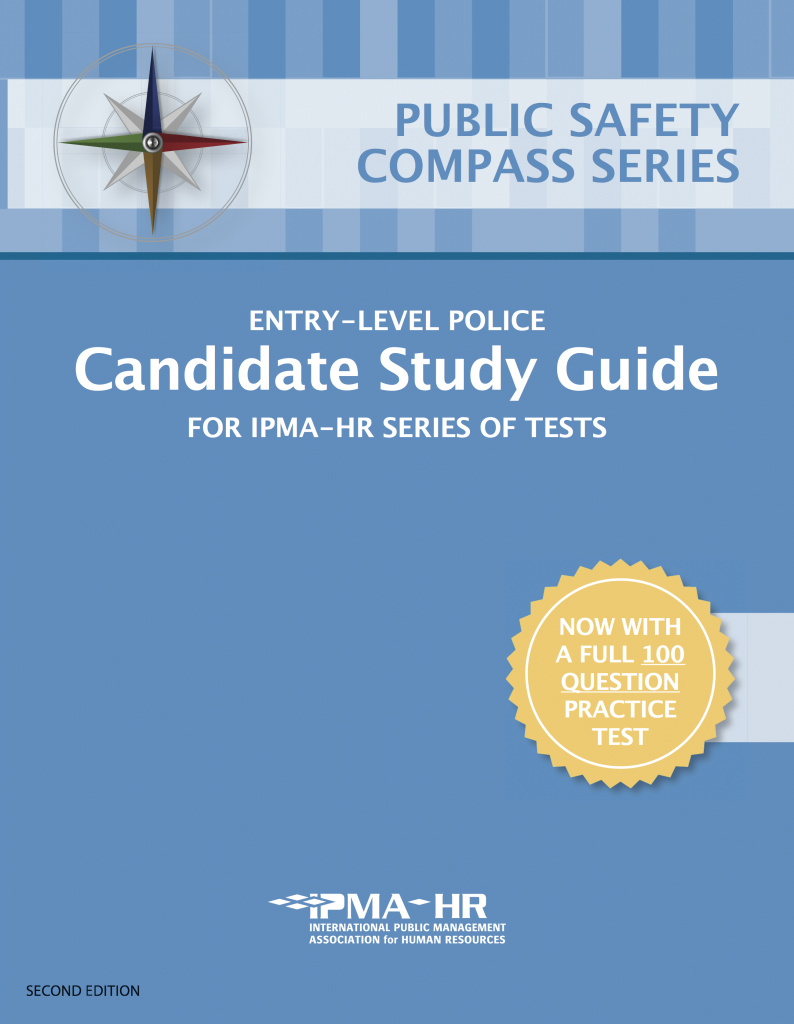Entry-Level Police Officer Candidate Study Guide Updated to 2nd Edition
We are pleased to announce the release of the 2nd edition of our popular Entry-Level Police Officer Candidate Study Guide.
For a limited time, we will be offering the 1st edition study guide to our test customers for $10 each.

The only difference between the 1st and 2nd edition of the study guide is the practice test, which has been updated to include an additional 75 questions for a total of 100 test items.
The updated study guide is immediately available for purchase by your candidates at Public Safety Compass at the same price as the 1st Edition, $20 plus postage.
For our test customers, the 2nd Edition study guide can be purchased for $15 each.
Candidate Reduction Strategies: Part 3
The first two articles in this series (part 1 and part 2) dealt with applicant reduction strategies. While not traditionally thought of as an applicant reduction strategy, we discussed how charging fees for testing can serve to reduce the applicant pool. Reducing the applicant pool can often be desirable since there are typically cost savings involved in relation to man power needed to handle applicants as they work their way through the selection process and efficiency benefits in regard to how quickly positions can be filled.
In addition to reducing the applicant pool by eliminating applicants that are not truly interested in the position being filled, charging fees can also help off set the costs incurred in the selection process. Karen Coffee, a Human Resources Consultant, made a presentation to a large segment of California Public Sector HR representatives in 1996, which was subsequently printed in Public Personnel Management, Vol. 25 No. 2 (Summer, 1996) in an article titled “To Fee, or Not to Fee.” Despite the fact that the article is now sixteen years old, the points she made are still relevant today. In fact, as time has gone on, and more and more jurisdictions have experienced financial challenges leading to budgetary restraints, the issue of charging fees may be even more relevant today than it was then. The full text of the article is available on this site. (more…)
Candidate Reduction Strategies: Part 2
Building on part 1 of this series on candidate reduction strategies, today we will provide more detail regarding the use of random numbers as part of a candidate reduction strategy. We will take a closer look at the issue of charging fees for filing a job application and/or testing, which can serve as an intentional or unintentional means of reducing the applicant pool. (more…)
Legal Update: Obesity Per Se is Impairment
Just a few months earlier, Michigan was the only state to have appearance as a protected characteristic. Add to this Montana, where the state supreme court ruled that obesity without an underlying physiological condition is covered by the Montana Human Rights Act in BNSF Railway Co. v. Feit, No. OP 11–0463, MT 7/6/2012. The action originated as a disability discrimination complaint in which Feit was upheld by the Montana Department of Labor and Industry. BNSF is incorporated in Delaware and sought review in federal, rather than state, court. The U.S. District Court for Montana asked the state supreme court for a determination of obesity under state law which, relying on EEOC interpretive guidance, found that weight outside normal range constituted an impairment. The ruling did not extend to a determination of whether Feit’s situation constituted a disability. The case is getting attention because of EEOC’s guidance playing a role, which might be taken up by other courts. (more…)
Candidate Reduction Strategies: Part 1
From time to time, the issue of candidate reduction strategies becomes the center of discussion in the Human Resources Field. In the current economic times it is not uncommon for employers to be besieged by far more applicants than necessary to fill current vacancies with well qualified candidates. In addition, many agencies are being forced to do more with less, in particular, less staff and less money. Combining these factors makes it imperative for HR shops to be efficient and this means working smarter, not harder, so appropriate candidate reduction strategies should be included with their other HR tools. (more…)
Legal Update: Job Analysis Generalized
The Second Circuit upheld a fire department promotional test in M.O.C.H.A. Society v. City of Buffalo, Nos. 11-2184-cv, 10-2168-cv, 7/30/2012. The two docket numbers are there because of separate appeals for testing in 1998 and 2002. In both cases district court (same judge) granted summary judgment to the city on disparate treatment regarding the 1998 testing and on the overall testing procedure in 2002. The court ruled for the city on disparate impact after a bench trial regarding the 1998 test and foreclosed litigation on what was essentially the same situation in 2002. Here’s what makes the case interesting, straight from the opinion of the Court of Appeals:
Can an employer show that promotional examinations having a disparate impact on a protected class are job related and supported by business necessity when the job analysis that produced the test relied on data not specific to the employer at issue? We answer that question in the affirmative based on the record developed in these related cases. While employer-specific data may make it easier for an employer to carry his burden in the second step of Title VII analysis, such evidence is not required as a matter of law to support a factual finding of job relatedness and business necessity.
The appellate court noted that the trial judge, John T. Curtin, had longstanding experience with promotions in the Buffalo Fire Department, starting with a 1978 finding of a pattern-or-practice of discrimination against African Americans, Latinos, and women. Presumably Judge Curtin would be no pushover for a weak showing of validity. (more…)
